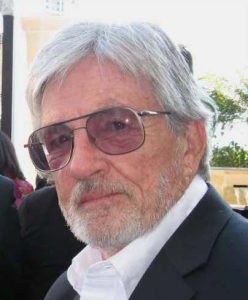Royce Adams

English Department, 1966-1988
Prior to my hiring in 1966, I spent seven years teaching at South High School in Torrance and one year at Long Beach City College during which time I became involved in developing high school reading courses and programs. While also teaching courses in reading for instructors through UCLA Extension, I met Miriam DeWitt, an SBCC English instructor enrolled in my class. She told me SBCC was looking for someone with my background to develop a reading program and encouraged me to apply for the position. I’ll be ever grateful to Miriam for bringing me to SBCC.
At the time of my hiring, there were only two reading classes, English 42 and English 43, so I also taught various composition courses. During this period, I was repeatedly told the college lacked the financial ability to develop a reading program beyond the courses we were offering. When Julio Bortolazzo became President/Superintendent in 1969, he was appalled that we did not have a reading center or a tutorial program. A powerhouse at getting things done, Bortolazzo went into action. Aware that there were state funds that could be used to develop basic skills programs, but a near-closing deadline for grant proposals, he sent what he called “his boys” Robert Carmen in the Math department and myself for an overnight stay in Sacramento with instructions to write a winning proposal or not come back. We wrote through the night and submitted our proposal the next day.
Our wish was granted and plans fell quickly into place. Room was found in the left wing of the Campus Center for a combined Reading Center and Tutorial Center. Bob started a basic math program for the Math Department using aids and tutors. Pablo Buckelew headed the Tutorial Center and I headed the Reading Center. While Pablo trained tutors to work with students from all academic subjects, I enlisted a core of tutors to assist in the Reading Center. Furniture and equipment in place, we opened for business after years of waiting, thanks to Bortolazzo. Though he stayed only one year at SBCC, he and his blue stationary with written ideas and demands made things happen. I was sorry to see him go.
The Reading Center worked with students with a wide range of reading, writing and study skills, from those learning English as a second language to those students struggling with reading and studying academic courses. To broaden the Center’s offerings, I wrote course outlines and materials for mini-courses in vocabulary development, accelerated reading, and how to study the sciences, the humanities, and the social sciences. Tutors were available in the Center and also assisted instructors in the classroom.
While in charge of the Reading Center, I continued to teach various literature and composition classes. I wrote the course outline for the first Native American literature class, taught contemporary fiction, and participated in the development of the Honors classes.
When Peter MacDougall became President/Superintendent in 1981, he approved the funding and establishment of a computer writing lab for the English department that Guy Smith and I proposed. One of the upstairs classrooms in what was then the library building was given over to the lab. Twenty Mac II computers were purchased and a lab assistant was hired to aid students in learning how to use word processing to write their assigned compositions. Guy and I each wrote a word processing manual for students, both of which quickly became useless as computer software developed faster than we could write.
After the Reading Center had become stable and working smoothly, I decided I needed a change. John Romo took over the Reading Center, and I returned to teaching literature and composition classes until my retirement in 1988.
After I retired, the Luria Library building was completed. All the original services of the Tutorial Center, Reading Center, the English computer center and other academic subject programs were combined and reorganized into the present Learning Resources Center which now includes a tutorial center, a writing center, computer access, media resources, computer classrooms, and learning skills workshops. If Julio Bortolazzo had not sent his “boys,” to Sacramento to obtain the funds for the initial programs, the Learning Resource Center as it exists today might have been much longer in coming.
I appreciate the many friendships with office mates and colleagues from various college departments I’ve enjoyed over the years. I value the connections I’ve made with students and what they have contributed to my understanding of myself. As SBCC grew into one of the best community colleges in the country, I hope that my contributions and teaching helped that growth in some way. I appreciate the endeavors of those faculty members who involved themselves in the political arena with the administration and board members over the years. I felt my energies were best directed toward writing student textbooks based on my teaching methods. Because our Reading Center became a showcase in the early 1970s, I became involved in helping other community colleges in developing their reading-study skills programs. I traveled and counseled for the Western Interstate Commission on Higher Education, and served as President of the College Reading and Learning Association from 1975-1976.
Most of all, I’m grateful SBCC hired Jane Brody, who eventually added me to her resume.